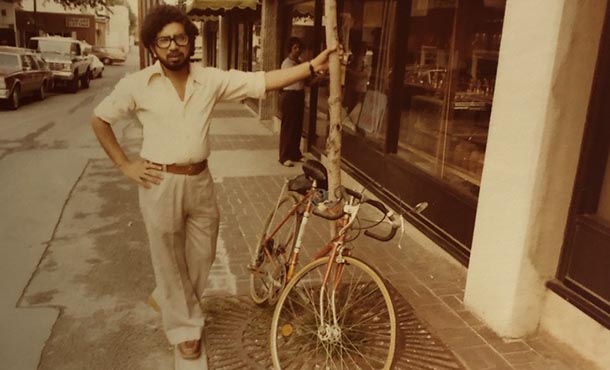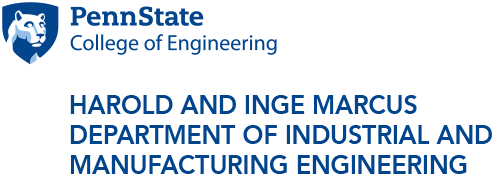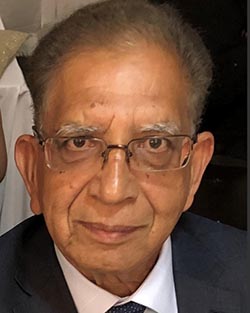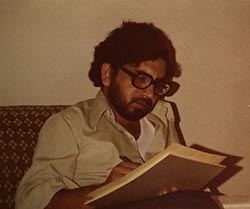
Nawaz came from Pakistan to further explore engineering studies in the United States. During his time at Penn State, he was working on his program while also raising a family. “It was a very interesting time,” Nawaz said. IMAGE: MUHAMMAD NAWAZ
Well cited: Engineering alumnus' decades-old work has stood the test of time
10/15/2019
By Miranda Buckheit
UNIVERSITY PARK, Pa. — As an industrial engineering graduate student in the late 1970s, Muhammad Nawaz was deep into collecting relevant literature to prove an idea for his minor thesis project. He didn’t expect it would continue to resonate nearly four decades later.
To date, Nawaz has accumulated nearly 2,400 citations for his thesis on how to organize an order of tasks, or jobs, for maximum efficiency. His work, titled “A Heuristic Algorithm for the m-Machine, n-Job Flow-shop Sequencing Problem,” led to the creation of a widely used research algorithm. Nawaz, who graduated from Penn State in 1980 with a master of engineering degree, was recently recognized by both the editors of Omega, the International Journal of Management Science, and the directors of Elsevier for his high citation count.
“Whenever I see a new citation for my paper, I feel proud that I have given something to the research field that is long-lasting,” Nawaz said.
“The heuristic was well ahead of its time,” said Soundar Kumara, Allen E. Pearce and Allen M. Pearce Professor of Industrial Engineering. “This is truly a remarkable achievement. Faculty may not get 2,400 citations for all their publications in their career.”
From 1979 to 1980, Nawaz worked tirelessly as a graduate student on his project under the supervision of former professors of industrial engineering E. Emory Enscore Jr. and Inyong Ham. The theory in his paper is popularly known as the “NEH algorithm” for Nawaz, Enscore and Ham. In addition to the high citation count, the algorithm has become a research topic itself with numerous articles dissecting the practical method.
From jobs in manufacturing plants, aircrafts waiting for landing clearance, customer orders in fast-food restaurants and programs to be executed within a computer, Nawaz’s work has proven to be useful across fields and disciplines.
“I’m glad to hear that Nawaz’s work found great success in both academia and industry,” said Ling Rothrock, professor and interim department head of the Harold and Inge Marcus Department of Industrial and Manufacturing Engineering at Penn State. “To see this algorithm stand the test of time by remaining relevant in various application fields such as medicine, military and computing is a testament to the impact Nawaz and his colleagues have had on industrial engineering.”
A simple method for a not-so-simple problem
In a variety of situations, it can be difficult to determine the order in which tasks should occur. Previous research on the topic of flow shop sequencing was insufficient. Nawaz decided to change that.
“You need to assume each job, like a product, customer order or paper file, has a different process time on each machine,” Nawaz said. “If you have two jobs, job one and job two, there are two possible sequences. You can have job one followed by job two or job two followed by job one. If you bump the problem up to three jobs, you get six possible sequences.”
As the number of jobs increases, the possible number of sequences grows exponentially, with 10 jobs resulting in more than 3 million possible sequences.
“Theoretically, you can find the optimal sequence for any number of jobs and any number of machines but for large numbers, the time required to get the optimal solution is unreasonable,” Nawaz said. “Heuristics, or simple methods, are devised to solve the problem. A good heuristic does not guarantee an optimal solution, but it provides a good solution in a reasonable time.”
How it all began
Nawaz was born in Lahore, Pakistan. As a child, he particularly enjoyed mathematics and physics. When he began intermediate college, which equates to the junior and senior years of high school in the United States, he began taking pre-engineering courses.
From his hard work, he was accepted to Pakistan’s University of Engineering and Technology (UET) in Lahore.
“At the time, UET Lahore was the best engineering university in Pakistan and it was the only engineering school in Punjab, which is one of the four provinces of Pakistan,” Nawaz said. “Engineering, much like medicine, is considered to be a very prestigious profession in Pakistan.”
Nawaz explained that he chose to opt for mechanical engineering with a production specialization. Following graduation, Nawaz began employment with a small steel mill as a professional engineer.
After three years with his first company, Nawaz decided to transition from industry to academia.
UET Lahore established a new campus, the University College of Engineering, in Taxila, Pakistan, where he was offered a teaching position. Following a year with UET, the university arranged a scholarship for Nawaz to travel overseas for graduate studies.
“I wanted to attend Penn State because I thought their industrial engineering program was the best option for me,” Nawaz said. “I returned to UET in Taxila after my graduation and stayed for about five years before my family and I moved to Melbourne, Australia, in 1986.”
Nawaz spent the next 25 years working for the Royal Melbourne Institute of Technology (RMIT) University. Nawaz taught several courses related to manufacturing management and supervised many final-year projects.
Due to his background, Nawaz also served as the program director for manufacturing and mechanical programs.
“While I didn’t do much research after my Penn State education, I stayed very close to academia and spent most of my time working with students in academic administration and mentoring,” Nawaz said. “Penn State greatly helped me in my career, and I wouldn’t have done it any differently.”
The alumni spotlight series from the Penn State Harold and Inge Marcus Department of Industrial and Manufacturing Engineering highlights innovators, makers and those that personify engineering excellence in industry and academia. Established in 1908, the department has graduated over 8,000 industrial engineers who can be found all across the world in varying industries. The department, home to the first industrial engineering program in the world, made a name for itself in the engineering industry through its storied tradition of unparalleled excellence and innovation in research, education and outreach. To learn more about the department and how to get involved, visit ime.psu.edu.





